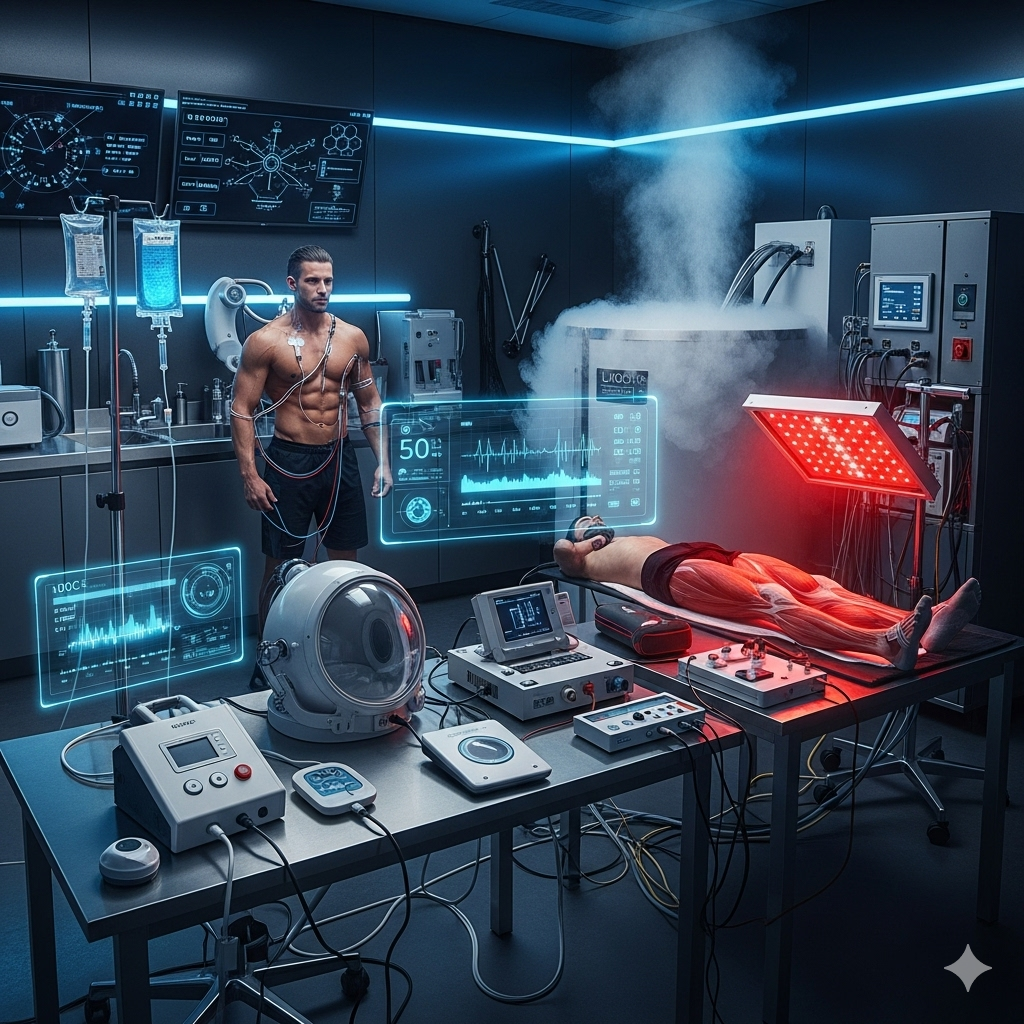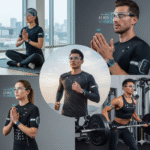For athletes and fitness enthusiasts, the pursuit of peak performance is a continuous journey that extends far beyond the confines of the gym or training field. While intense workouts and meticulous nutrition are undeniably crucial, the often-overlooked third pillar—recovery—is equally, if not more, vital for sustainable progress and injury prevention. Traditional recovery methods like stretching and adequate rest are foundational, but the world of biohacking offers a suite of advanced strategies designed to accelerate healing, reduce muscle soreness, and optimize physiological restoration at a cellular level. This blog post will delve into cutting-edge biohacking recovery techniques, from the chilling embrace of cold plunges to the therapeutic glow of red light, empowering you to transform your recovery process from passive to proactive and unlock your body’s innate healing potential.
The Science of Muscle Repair and Recovery
To truly appreciate advanced recovery strategies, it’s essential to understand the underlying physiological processes involved in muscle repair and recovery. Intense exercise, particularly resistance training or high-impact activities, causes microscopic damage to muscle fibers. This damage, while necessary for adaptation and growth, triggers an inflammatory response that can lead to Delayed Onset Muscle Soreness (DOMS), characterized by pain, stiffness, and reduced muscle function.
Recovery is the body’s intricate process of repairing this damage, clearing metabolic byproducts, and adapting to the training stimulus. This involves a complex interplay of cellular mechanisms, including protein synthesis, immune responses, and the restoration of energy stores. The goal of any recovery strategy is to facilitate these natural processes, reduce excessive inflammation, and accelerate the return to optimal function, thereby allowing for consistent training and continuous improvement.
Advanced Biohacking Recovery Modalities
Moving beyond conventional methods, biohacking recovery leverages scientific principles and innovative technologies to optimize the body’s restorative capabilities. These modalities target specific physiological pathways to enhance healing and reduce recovery time.
Cold Therapy (Cryotherapy & Cold Plunges)
Cold therapy, ranging from ice baths to whole-body cryotherapy, has long been a staple in athletic recovery. The mechanism behind its effectiveness involves vasoconstriction—the narrowing of blood vessels—which helps to reduce blood flow to the affected areas, thereby minimizing swelling and inflammation. This also aids in pain signaling modulation, providing significant pain relief [1].
For athletes, the benefits are multifaceted: accelerated recovery, reduced DOMS, and even enhanced mental resilience. Ice baths, for instance, have been shown to reduce muscle soreness by as much as 20% [2]. While some studies suggest caution regarding muscle growth adaptations immediately post-workout, cold therapy remains a powerful tool for acute pain relief and inflammation management. Professional cryotherapy chambers offer a more controlled and intense cold exposure, providing similar benefits with shorter exposure times [3].
Heat Therapy (Saunas & Infrared)
In contrast to cold, heat therapy promotes vasodilation—the widening of blood vessels—which increases blood flow to muscles. This enhanced circulation aids in the delivery of oxygen and nutrients while facilitating the removal of metabolic waste products. Heat also helps to relax muscles, reduce stiffness, and improve flexibility.
Saunas, both traditional and infrared, are popular forms of heat therapy. Beyond muscle relaxation, regular sauna use has been linked to benefits such as improved cardiovascular health, detoxification, and even a modest increase in growth hormone release. For athletes, heat therapy can be particularly beneficial for pre-workout warm-ups, improving tissue elasticity, and post-workout relaxation to aid in recovery.
Contrast Therapy
Contrast therapy involves alternating between hot and cold exposure. This method creates a ‘pumping’ effect, where blood vessels rapidly constrict and dilate. This action is believed to enhance circulation, reduce swelling, and facilitate the removal of waste products from muscles. While the exact mechanisms are still being researched, many athletes report subjective benefits in terms of reduced soreness and improved recovery after using contrast baths or showers.
Red Light Therapy (Photobiomodulation)
Red Light Therapy (RLT), also known as photobiomodulation (PBM), is an emerging biohack that utilizes specific wavelengths of red and near-infrared light to stimulate cellular function. The mechanism involves the absorption of light by chromophores within the cells, particularly in the mitochondria, leading to increased ATP (cellular energy) production, reduced oxidative stress, and modulated inflammatory responses [4].
For athletes, RLT offers a range of benefits: enhanced muscle repair, reduced inflammation, and improved circulation [5]. Studies suggest that RLT can increase muscle mass after training and decrease oxidative stress [6]. It is considered a promising non-surgical method for inducing skeletal muscle regeneration [7]. RLT can be applied using full-body panels or targeted handheld devices, making it accessible for home use.
Targeted Myofascial Release & Massage
Myofascial release techniques aim to alleviate tension and restrictions in the fascia, the connective tissue that surrounds muscles, bones, and organs. Techniques like deep tissue massage, foam rolling, and percussive therapy (using massage guns) apply pressure to specific areas to release knots and improve tissue mobility. Percussive therapy, delivered by massage guns, has been shown to improve acute muscle strength, explosive muscle strength, flexibility, and reduce musculoskeletal pain [8]. It also reduces recovery time, relieves muscle soreness and stiffness, and enhances range of motion [9]. These tools promote blood circulation, break down lactic acid, and help relieve muscle soreness [10]. Self-myofascial release (SMR) has been shown to have acute positive effects on flexibility and range of motion [11].
Integrating Advanced Recovery into Your Routine
Successfully incorporating these advanced biohacking recovery strategies requires thoughtful planning and personalization. There’s no one-size-fits-all approach, and the optimal timing and combination of modalities will depend on your individual needs, training intensity, and recovery goals.
- Timing is Key: Consider when to use each modality. Cold therapy is often used immediately post-workout to reduce acute inflammation, while heat therapy might be better for pre-workout warm-ups or general relaxation on rest days. Red light therapy can be used both before and after workouts to prime muscles and aid repair.
- Stacking Modalities: Experiment with combining different techniques for synergistic effects. For example, a short cold plunge followed by a sauna session (contrast therapy) can be highly effective for some individuals.
- Listen to Your Body: Pay close attention to how your body responds to each intervention. Track your subjective feelings of soreness, energy levels, and objective metrics like heart rate variability (if you use a wearable device). Adjust your protocol based on this feedback.
- Consistency: Like training, consistency is crucial for recovery. Regular application of these biohacks will yield the best long-term results.
Conclusion: The Competitive Edge of Optimal Recovery
In the competitive landscape of fitness and athletics, optimal recovery is the ultimate competitive edge. By embracing advanced biohacking recovery strategies—from the therapeutic benefits of cold and heat therapy to the cellular regeneration offered by red light therapy and the targeted relief of percussive devices—you can significantly accelerate your body’s healing processes. These innovative tools empower you to reduce muscle soreness, prevent injuries, and return to peak performance faster and more consistently. Biohacking recovery is about taking an active, informed role in your body’s restoration, transforming downtime into a powerful component of your training. By prioritizing and optimizing your recovery, you’re not just healing; you’re building a more resilient, adaptable, and high-performing version of yourself, ready to conquer new challenges and achieve your ultimate fitness potential.
References:
[1] EFFECT OF COLD AND HEAT THERAPIES ON PAIN RELIEF IN… Pmc.ncbi.nlm.nih.gov. Available at: https://pmc.ncbi.nlm.nih.gov/articles/PMC8862647/
[2] Hot bath or ice bath – which is best for recovery? – Runner’s World. Runnersworld.com. Available at: https://www.runnersworld.com/uk/training/a776522/hot-bath-or-ice-bath-which-is-best-for-recovery/
[3] Cryotherapy for Athletes: How it works, Benefits. Massgeneralbrigham.org. Available at: https://www.massgeneralbrigham.org/en/about/newsroom/articles/cryotherapy-for-athletes
[4] Photobiomodulation in human muscle tissue: an advantage in sports… Pmc.ncbi.nlm.nih.gov. Available at: https://pmc.ncbi.nlm.nih.gov/articles/PMC5167494/
[5] Red Light Therapy: What it is and Uses for Athletes by Liam Sutton. Athleticlab.com. Available at: https://www.athleticlab.com/red-light-therapy-for-athletes/
[6] Red Light Therapy and Muscle Recovery – Physiopedia. Physio-pedia.com. Available at: https://www.physio-pedia.com/Red_Light_Therapy_and_Muscle_Recovery
[7] Photobiomodulation therapy (PBMT) in skeletal muscle regeneration. Sciencedirect.com. Available at: https://www.sciencedirect.com/science/article/pii/S1572100025000514
[8] The Effect Of Percussive Therapy On Musculoskeletal Performance… Pmc.ncbi.nlm.nih.gov. Available at: https://pmc.ncbi.nlm.nih.gov/articles/PMC10069390/
[9] The 5 Benefits of percussion therapy: Is it worth it? – Hyperice. Hyperice.com. Available at: https://hyperice.com/blog/treatment/percussion-therapy-benefits/
[10] Amazon.com: Massage Gun Deep Tissue,Percussion Back… Amazon.com. Available at: https://www.amazon.com/Massage-Tissue-Percussion-Massager-Athletes/dp/B09JBCSC7H
[11] Effects of Self-Myofascial Release on Athletes’ Physical Performance. Pmc.ncbi.nlm.nih.gov. Available at: https://pmc.ncbi.nlm.nih.gov/articles/PMC10801590/

